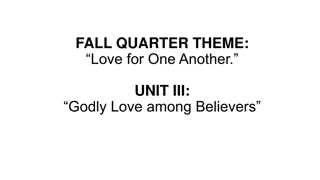The Lesson of Humility and Service in Jesus Washing the Disciples' Feet
In the account of Jesus washing the disciples' feet, a lesson on humility and service was portrayed rather than the institution of a collective worship act. This act of love and service symbolized cleansing and exemplified the disciples' duty to follow their teacher's example of serving others selflessly. The act of washing feet was traditionally a servant's task, emphasizing humility and hospitality. The church did not establish foot washing as a ritual but instead viewed it as an individual act of service. Ultimately, the message conveyed is that true service requires humility and selfless dedication, reflecting Christ's own sacrificial love.
Uploaded on Sep 24, 2024 | 0 Views
Download Presentation

Please find below an Image/Link to download the presentation.
The content on the website is provided AS IS for your information and personal use only. It may not be sold, licensed, or shared on other websites without obtaining consent from the author. Download presentation by click this link. If you encounter any issues during the download, it is possible that the publisher has removed the file from their server.
E N D
Presentation Transcript
I. The Account of Jesus Washing the Disciples Feet (John 13:1-17). The supper was ended (2), so the memorial had already been instituted (cf. Matt. 26:26 as they were eating ). This is not an element of the memorial. Loved them to the end (1). This was an act of love. There was symbolism in the act (8- 10) they were clean He has already cleansed them.
I. The Account of Jesus Washing the Disciples Feet (John 13:1-17). They would understand after this (7). What does He lead them to understand (12)? Disciples ought to do what their Teacher has done (13-14). A servant behaves like his Master(16- 17), and is blessed in this.
I. The Account of Jesus Washing the Disciples Feet (John 13:1-17). It is an example (15). Gr. Hupo- deigma from verb meaning to show by placing under (i.e. before) the eyes (Thayer). The things of the tabernacle were an example (Heb. 8:5) or pattern of heavenly things (Heb. 9:23, KJV). Prophets examples of endurance under suffering (James 5:10). Sodom and Gomorrah are an example of punishment (2 Pet. 2:6).
I. The Account of Jesus Washing the Disciples Feet (John 13:1-17). One can follow an example of unbelief (Heb. 4:11). This is not a word that speaks strictly of a religious practice.
II. Foot Washing in General Practice. An act of hospitality (Gen. 18:1-4; 19:1-2; 24:29-32). Usually done to one s own feet (cf. Luke 7:44). Considered the act of a servant (1 Sam. 25:40-41). Praised when done to Jesus as an act of humility and repentance (Luke 7:38, 44).
III. What Did the Church Do? There is no example of this being done as a ritual or as a collective action of the church. It is considered an individual action (1 Tim. 5:9-10) if it was a church ritual all Christian widows would be assumed to have done it. John Calvin By a figure of speech, in which a part is taken for the whole, he means by the washing of the feet all the services which are commonly rendered to the saints (Commentary on First Timothy).
Conclusion. This was a lesson on humility and service not the institution of an act of collective worship. Service may require much more than just washing feet it could require laying down our life (1 John 3:16-18). The disciple of Christ must not be too proud to offer service to others.

















































